This BalloonDecorator Project is one that I am using on a current project to show help hints and error notifications. I know you could modify your error template to show this decorator, just like you could show an icon instead of the red borders. The benefit of using a decorator is you can make it look however you'd like, and won't have to depend on WinForms.
BalloonDecorator.cs
using System;
using System.Windows;
using System.Windows.Controls;
using System.Windows.Media;
namespace MyNamespace
{
public class BalloonDecorator : Decorator
{
private static double _thickness = 0;
private static int OpeningGap = 10;
public static readonly DependencyProperty BackgroundProperty =
DependencyProperty.Register("Background", typeof (Brush), typeof (BalloonDecorator));
public static readonly DependencyProperty BorderBrushProperty =
DependencyProperty.Register("BorderBrush", typeof (Brush), typeof (BalloonDecorator));
public static readonly DependencyProperty PointerLengthProperty =
DependencyProperty.Register("PointerLength", typeof (double), typeof (BalloonDecorator),
new FrameworkPropertyMetadata(10.0, FrameworkPropertyMetadataOptions.AffectsRender |
FrameworkPropertyMetadataOptions.AffectsMeasure));
public static readonly DependencyProperty CornerRadiusProperty =
DependencyProperty.Register("CornerRadius", typeof (double), typeof (BalloonDecorator),
new FrameworkPropertyMetadata(10.0, FrameworkPropertyMetadataOptions.AffectsRender |
FrameworkPropertyMetadataOptions.AffectsMeasure));
public Brush Background
{
get { return (Brush) GetValue(BackgroundProperty); }
set { SetValue(BackgroundProperty, value); }
}
public Brush BorderBrush
{
get { return (Brush) GetValue(BorderBrushProperty); }
set { SetValue(BorderBrushProperty, value); }
}
public double PointerLength
{
get { return (double) GetValue(PointerLengthProperty); }
set { SetValue(PointerLengthProperty, value); }
}
public double CornerRadius
{
get { return (double) GetValue(CornerRadiusProperty); }
set { SetValue(CornerRadiusProperty, value); }
}
protected override Size ArrangeOverride(Size arrangeSize)
{
UIElement child = Child;
if (child != null)
{
double pLength = PointerLength;
Rect innerRect =
Rect.Inflate(new Rect(pLength, 0, Math.Max(0, arrangeSize.Width - pLength), arrangeSize.Height),
-1 * _thickness, -1 * _thickness);
child.Arrange(innerRect);
}
return arrangeSize;
}
protected override Size MeasureOverride(Size constraint)
{
UIElement child = Child;
Size size = new Size();
if (child != null)
{
Size innerSize = new Size(Math.Max(0, constraint.Width - PointerLength), constraint.Height);
child.Measure(innerSize);
size.Width += child.DesiredSize.Width;
size.Height += child.DesiredSize.Height;
}
Size borderSize = new Size(2 * _thickness, 2 * _thickness);
size.Width += borderSize.Width + PointerLength;
size.Height += borderSize.Height;
return size;
}
protected override void OnRender(DrawingContext dc)
{
Rect rect = new Rect(0, 0, RenderSize.Width, RenderSize.Height);
dc.PushClip(new RectangleGeometry(rect));
dc.DrawGeometry(Background, new Pen(BorderBrush, _thickness), CreateBalloonGeometry(rect));
dc.Pop();
}
private StreamGeometry CreateBalloonGeometry(Rect rect)
{
double radius = Math.Min(CornerRadius, rect.Height / 2);
double pointerLength = PointerLength;
// All the points on the path
Point[] points =
{
new Point(pointerLength + radius, 0), new Point(rect.Width - radius, 0), // Top
new Point(rect.Width, radius), new Point(rect.Width, rect.Height - radius), // Right
new Point(rect.Width - radius, rect.Height), // Bottom
new Point(pointerLength + radius, rect.Height), // Bottom
new Point(pointerLength, rect.Height - radius), // Left
new Point(pointerLength, radius) // Left
};
StreamGeometry geometry = new StreamGeometry();
geometry.FillRule = FillRule.Nonzero;
using (StreamGeometryContext ctx = geometry.Open())
{
ctx.BeginFigure(points[0], true, true);
ctx.LineTo(points[1], true, false);
ctx.ArcTo(points[2], new Size(radius, radius), 0, false, SweepDirection.Clockwise, true, false);
ctx.LineTo(points[3], true, false);
ctx.ArcTo(points[4], new Size(radius, radius), 0, false, SweepDirection.Clockwise, true, false);
ctx.LineTo(points[5], true, false);
ctx.ArcTo(points[6], new Size(radius, radius), 0, false, SweepDirection.Clockwise, true, false);
// Pointer
if (pointerLength > 0)
{
ctx.LineTo(rect.BottomLeft, true, false);
ctx.LineTo(new Point(pointerLength, rect.Height - radius - OpeningGap), true, false);
}
ctx.LineTo(points[7], true, false);
ctx.ArcTo(points[0], new Size(radius, radius), 0, false, SweepDirection.Clockwise, true, false);
}
return geometry;
}
}
}
Just make sure that this class's namespace is loaded into the XAML imports (I use a namespace called "Framework"), and it is simple to use:
<Framework:BalloonDecorator Background="#FFFF6600" PointerLength="50"
CornerRadius="5" Opacity=".9" Margin="200,120,0,0"
HorizontalAlignment="Left" VerticalAlignment="Top" Visibility="{Binding UnitPriceChangedBalloonVisibility}">
<Border CornerRadius="2">
<Border CornerRadius="2">
<Button Height="Auto" Command="{Binding CloseUnitPriceChangedBalloonCommand}" Background="Transparent" BorderBrush="{x:Null}">
<TextBlock Text="Please review the price. The Units have changed."
HorizontalAlignment="Left"
VerticalAlignment="Top"
FontStyle="Italic"
TextWrapping="Wrap"
Margin="10"
/>
</Button>
</Border>
</Border>
</Framework:BalloonDecorator>
Obviously, I tie the visibility to a binding, but you could just set it to true and put this inside your Validation.ErrorTemplate.
Hope this helps!
